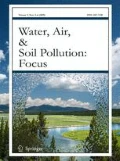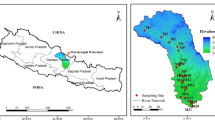Abstract
Industrialization and urbanization along the coastal population centers have brought great changes in the land cover and material fluxes from watersheds to receiving bays and estuaries. We have embarked a multiyear research project on “Watersheds Nutrient Loss and Eutrophication of Jiaozhou Bay” for the period of 2000 to 2004, funded by the Natural Science Foundation of China to examine human influence on the marine sector of ecosystem. Jiaozhou Bay, located in the southern part of Shandong Peninsula, was selected because of the existence of long-term hydrographic and meteorological records since the 1930s and recent observations on the marine ecological variables. We have made extensive and periodic measurements on the water movement, nutrients, phytoplankton, and microbe in water column and bottom sediments. Box and 3-dimensional hydrodynamic models were developed and utilized to understand the evolution of eutrophic status with time. It was found that primary productivity has suffered from silica depletion followed by phosphate, and the dominance of large phytoplankton has been replaced by small-size communities. These ecosystem changes were brought by the changes in the relative contribution among major pathways and concentrations, owing to the human activities in the watershed. Eight articles in this volume reported various aspects of the linkage between watershed human activities and ecosystem for the Jiaozhou Bay as the initial outcome of this project.









Similar content being viewed by others
References
Anderson, D. M., Kulis, D. M., Orphanus, J. A., & Ceurvels, A. R. (1982). Distribution of toxic red tide dinoflagellate Gonyaulax tamarensis in the southern New England region. Estuarine, Coastal and Shelf Science, 14, 447–458.
Bai, J., Li, K. R., Liu, D. Y., Zhang, J., Zhang, H. F., Liu, G. S., et al. (2007). Seasonal variation of inorganic nutrient uptake by heterotrophic bacterioplankton in Jiaozhou Bay, North China. Water, Air and Soil Pollution: Focus. (this volume).
Carpenter, S. R., Ludwig, D., & Brock, W. A. (1999). Management of eutrophication for lakes subject to potentially irreversible changes. Ecological Applications, 9, 751–771.
Cerco, F. (1995a). Simulation of long-term trends in the Chesapeake Bay eutrophication. Journal of Environmental Engineering, 121, 298–310.
Cerco, F. (1995b). Response of Chesapeake Bay to nutrient load reductions. Journal of Environmental Engineering, 121, 549–557.
Cho, B. C., & Azam, F. (1990). Biogeochemical significance of bacterial biomass in the ocean’s euphotic zone. Marine Ecology Progress Series, 63, 263-279.
Conley, D. J., & Johnstone, R. W. (1995). Biogeochemistry of N, P and Si in Baltic Sea sediments: Response to a simulated deposition of a spring diatom bloom. Marine Ecology Progress Series, 122, 1–3.
GEOHAB (2001). Global Ecology and Oceanography of Harmful Algal Blooms, Science Plan. In P. Glibert & G. Pitcher (Eds.), SCOR and IOC, Baltimore and Paris, 87 pp.
Henriksen, A., & Henssen, D. O. (1997). Whole catchment studies on nitrogen cycling: Nitrogen from mountains to fjords. Ambio, 26, 254–257.
Henssen, D. O., Hinder, A., & Holtan, G. (1997). The significance of nitrogen runoff for eutrophications of freshwaters and marine recipients. Ambio, 26, 312–320.
Humborg, C. V., Ittekkot, V., Cociasu, A., & Bodungen, B. V. (1997). Effect of Danube River dam on Black Sea biogeochemistry and ecosystem structure. Nature, 368, 385–388.
IMBER (2005). Science Plan and Implementation Strategy. IGBP Report No. 52, IGBP Secretariat, Stockholm, 76 pp.
Liu, D. Y., Bai, J., Song, S. Q., Zhang, J., Sun, P., Li, Y., et al. (2007a). The impact of sewage discharge on the macroalgae community in the Yellow Sea coastal area around Qingdao, China. Water, Air and Soil Pollution: Focus. (this volume).
Liu, D. Y., Sun, J., Zou, J. Z., & Zhang, J. (2005a). Phytoplankton succession during a red tide of Skeletonema costatum in Jiaozhou Bay of China. Marine Pollution Bulletin, 50, 91–94.
Liu, G. Q., Wang, S. Y., Zhu, X. J., Liu, S. M., & Zhang, J. (2007b). Groundwater and nutrient discharge into Jiaozhou Bay, North China. Water, Air and Soil Pollution: Focus. (this volume).
Liu, G .S., Liu, S. M., Zhang, J., Huang, Y. P., & Chen, M. (2007c). Sedimentary processes of the Qingdao near-shore traced using a multi-radionuclide approach. Water, Air and Soil Pollution: Focus. (this volume).
Liu, S. M., Li, X. N., Zhang, J., Wei, H., Ren, J. L., & Zhang, G. L. (2007d). Nutrient dynamics in Jiaozhou Bay. Water, Air and Soil Pollution: Focus. (this volume).
Liu, S. M., Zhang, J., Chen, H. T., & Zhang, G. S. (2005b). Factors influencing nutrient dynamics in the eutrophic Jiaozhou Bay, North China. Progress in Oceanography, 66, 66–85.
Liu, Z., Wei, H., Bai, J., Zhang, J., Liu, D. Y., & Liu, S. M. (2007e). Nutrients seasonal variation and budget in Jiaozhou Bay, China: A 3-dimensional physical-biological coupled model study. Water, Air and Soil Pollution: Focus. (this volume).
Liu, Z., Wei, H., Liu, G. S., & Zhang, J. (2004). Simulation of water exchange in the Jiaozhou Bay by average residence time approach. Estuarine, Coastal and Shelf Science, 61, 25–35.
LOICZ, (2005). Science Plan and Implementation Strategy. IGBP Report No. 51, IGBP Secretariat, Stockholm, 60 pp.
Mulder, J., Nilser, P., Stuanes, A. O., & Huse, M. (1997). Nitrogen pools and transformations in Norwegian forest ecosystems with different atmospheric inputs. Ambio, 26, 273–281.
Paerl, H. W. (1997). Coastal eutrophication and harmful algal blooms: Importance of atmospheric deposition and ground water as “new” nitrogen and other nutrient sources. Limnology and Oceanography, 42, 1154–1165.
Patsch, J., & Radach, G. (1997). Long-term simulation of the eutrophication of the North Sea – Temporal development of nutrients, chlorophyll-a and primary production in comparison to observations. Journal of Sea Research, 38, 275–310.
Ren, J. L., Zhang, J., Li, D. D., Cheng, Y., & Liu, S. M. (2007). Speciation and seasonal variations of dissolved inorganic arsenic in Jiaozhou Bay, North China. Water, Air and Soil Pollution: Focus. (this volume).
Qingdao Municipal Statistics Bureau, (2005). Qingdao Statistical Yearbook - 2004 (p 380). Beijing: China Statistics Press (in Chinese).
Scaria, D. (1988). On the role of bacteria production. Limnology and Oceanography, 33, 220–224.
Shen, Z. L. (2001). Historical changes in nutrient structure and its influences on phytoplankton composition in Jiaozhou Bay. Estuarine, Coastal and Shelf Science, 52, 211–224.
Smayda, T. J. (1997). Harmful algal blooms: Their eco-physiology and general relevance to phytoplankton blooms in the sea. Limnology and oceanography, 42, 1137–1153.
Turner, R. E., & Rabalais, N. N. (1994). Coastal eutrophication near the Mississippi River Delta. Nature, 368, 619–621.
Yang, D. F., Zhang, J., Lu, J. B., Gao, Z. H., & Chen, Y. (2002). Examination of silicate limitation of primary production in the Jiaozhou Bay, China I: Silicate being a limiting factor of phytoplankton primary production. Chinese Journal of Oceanography and Limnology, 20, 208–225.
Yang, S. L., Zhang, J., & Zhu, J. (2004). Response of suspended sediment concentrations to tidal dynamics at a site inside the mouth of an inlet: Jiaozhou Bay (China). Hydrology and Earth System Sciences, 8, 170–182.
Zhang, G. L., Zhang, J., Xu, J., Ren, J. L., & Liu, S. M. (2007). Distributions, land-source input and atmospheric fluxes of methane in Jiaozhou Bay. Water, Air and Soil Pollution: Focus. (this volume).
Zhang, J. (1994). Atmospheric wet depositions of nutrient elements: Correlation with harmful biological blooms in the Northwest Pacific coastal ocean. Ambio, 23, 464–468.
Acknowledgments
The author is indebted to the Natural Science Foundation of China (NSFC), which supports the present study under contract No. 40036010. Colleagues from the research group of marine biogeochemistry of OUC and ECNU are acknowledged for their assistances in the field observations and laboratory work. Drs. G.H. Hong and X.C. Wang are acknowledged for their comments and suggestions, which improved the original manuscript.
Author information
Authors and Affiliations
Corresponding author
Rights and permissions
About this article
Cite this article
Zhang, J. Watersheds Nutrient Loss and Eutrophication of the Marine Recipients: A Case Study of the Jiaozhou Bay, China. Water Air Soil Pollut: Focus 7, 583–592 (2007). https://doi.org/10.1007/s11267-007-9130-1
Received:
Revised:
Accepted:
Published:
Issue Date:
DOI: https://doi.org/10.1007/s11267-007-9130-1




